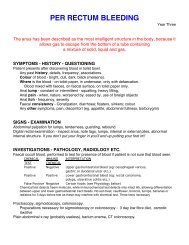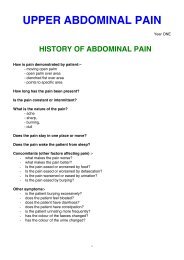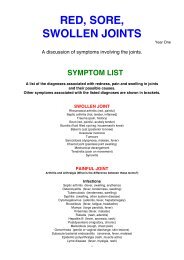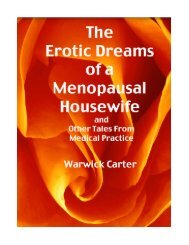Menopause A to Z.pdf - Medwords.com.au
Menopause A to Z.pdf - Medwords.com.au
Menopause A to Z.pdf - Medwords.com.au
You also want an ePaper? Increase the reach of your titles
YUMPU automatically turns print PDFs into web optimized ePapers that Google loves.
MENOPAUSE A <strong>to</strong> Z<br />
In a vaginal hysterec<strong>to</strong>my, there is no scar on the abdomen as the entire operation is performed through the vagina.<br />
The recovery time is not quite as long as for the open operation, but the operation is more technically difficult, and in<br />
most centres has been replaced by laparoscopic hysterec<strong>to</strong>my.<br />
Laparoscopic hysterec<strong>to</strong>mies were first performed in the late 1980s, and are now the most <strong>com</strong>mon form of the<br />
operation, but not all women are suitable candidates. It involves four incisions in the abdomen, each about one<br />
centimetre long, and through these, thin tubes are introduced. These laparoscopic tubes are used <strong>to</strong> see what is<br />
happening inside the abdomen using a camera or direct vision, and <strong>to</strong> introduce instruments <strong>to</strong> perform the operation.<br />
When the uterus and tubes have been cut free from the supporting structures, they are removed through the vagina.<br />
There is much less pain after this operation, the hospital stay is only one or two nights, and patients recover <strong>com</strong>pletely<br />
in two <strong>to</strong> three weeks. There are fewer <strong>com</strong>plications than with open surgery as less tissue damage occurs.<br />
An alternative <strong>to</strong> hysterec<strong>to</strong>my in some circumstances (eg: heavy bleeding) is microwave endometrial ablation.<br />
Most women who have the operation for good reasons are very grateful bec<strong>au</strong>se they no longer need <strong>to</strong> spend a<br />
week or more each month cloistered away from society bec<strong>au</strong>se of menstrual flooding and cramps.<br />
Any woman contemplating a hysterec<strong>to</strong>my, or who has been advised <strong>to</strong> have one, should take along a list <strong>to</strong> ensure<br />
that her gynaecologist or general practitioner adequately answers all her questions and concerns. Obtaining a second<br />
opinion from another gynaecologist may further reassure the woman that the operation is her best option. In this way,<br />
many problems can be avoided.<br />
See also MICROWAVE ENDOMETRIAL ABLATION; OVARY; UTERUS<br />
INCONTINENCE OF URINE<br />
This is the inability <strong>to</strong> control the outflow of urine so that wetting of clothing or bedding occurs. It is a problem that<br />
affects women far more than men. Repeated urinary infections may be a <strong>com</strong>plication.<br />
In women, there is normally an acute angle between the bladder and the opening in<strong>to</strong> the urethra (tube leading <strong>to</strong><br />
the outside) - see diagram below. If this angle is reduced for any reason, the woman will be<strong>com</strong>e more prone <strong>to</strong> urinary<br />
incontinence.<br />
Alcohol and caffeine are both known <strong>to</strong> increase the production of urine, and if <strong>to</strong>o much of the former is consumed,<br />
the person may lose their inhibitions and urinate inappropriately.<br />
A sudden severe fright or shock, and extreme fear, may c<strong>au</strong>se loss of bladder control.<br />
An infection of the bladder or kidney will result in the frequent, painful passage of small amounts of urine. Women<br />
may find their control of urination <strong>to</strong> be <strong>com</strong>promised with these infections.<br />
Childbirth can c<strong>au</strong>se damage <strong>to</strong> the muscles that control the release of urine, and may result in long term problems,<br />
so that every time the woman l<strong>au</strong>ghs, coughs or exercises, she passes a small amount of urine. The loss of muscle<br />
<strong>to</strong>ne in the floor of the pelvis can result in the same problem. The female hormone oestrogen maintains the muscle<br />
<strong>to</strong>ne in this area, so the lack of oestrogen at menop<strong>au</strong>se is usually responsible. Obesity will further aggravate the<br />
problem. Pelvic floor exercises supervised by a physiotherapist, hormone replacement therapy, weight loss and<br />
surgery can all help control these c<strong>au</strong>ses of incontinence.<br />
Detrusor hyperactivity is an excessive sensitivity of a muscle that forms a sac around the scrotum in the groin. A<br />
spasm of this muscle puts pressure on the bladder and reduces the control of urination by the muscles around the<br />
bladder opening in<strong>to</strong> the urethra c<strong>au</strong>sing the affected man <strong>to</strong> suddenly and uncontrollably pass urine.<br />
A number of medications may aggravate incontinence. Examples include blood pressure medications (particularly<br />
prazosin), fluid producing medications (diuretics), tranquillisers, lithium and some depression treating drugs (tricyclics).<br />
Other c<strong>au</strong>ses of urinary incontinence include surgery <strong>to</strong> the pelvis and genitals (eg. hysterec<strong>to</strong>my), a stroke, loss of<br />
consciousness, epileptic fit, damage <strong>to</strong> the brain (eg. cerebral palsy, tumour, Parkinson’s disease), senility or dementia<br />
(eg. Alzheimer disease), tumours or s<strong>to</strong>nes in the bladder, pelvic injury, multiple sclerosis, injury <strong>to</strong> the spinal cord (eg.<br />
paraplegia or quadriplegia), trigonitis, poorly controlled diabetes mellitus and diabetes insipidus.<br />
A fistula (abnormal opening) between the bladder and vagina may be c<strong>au</strong>sed by a very difficult childbirth,<br />
26









